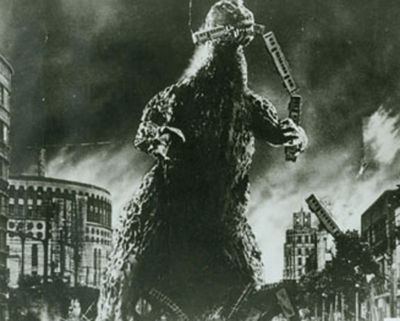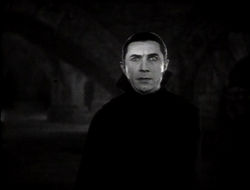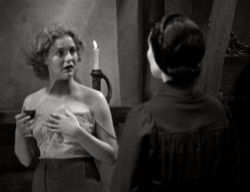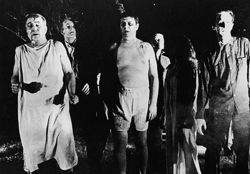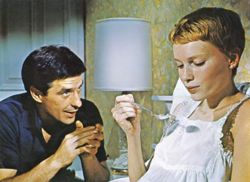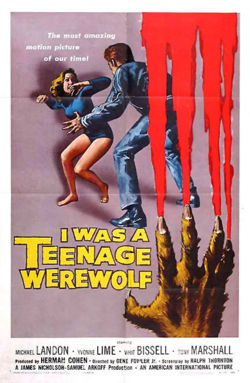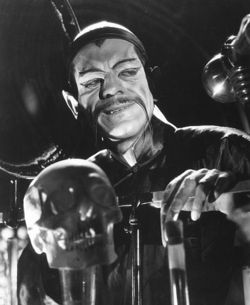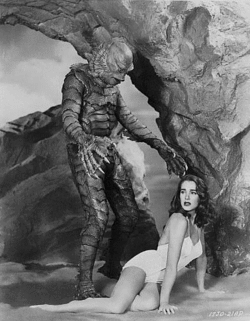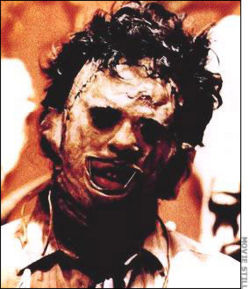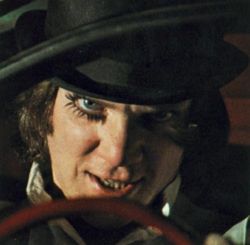The Horror Genre and Social Commentary
From mediaartiststudio
Horror is a phenomenon in human culture much older than film or even literature. It’s roots lie in folklore and past that may even lie in our evolutionary instinct. Anthropologist David E. Jones, for example, in his book, “An Instinct For Dragons”, explains the almost universal image of the dragon in so many cultures around the world as stemming from the instinctual fear of our natural predators throughout our evolution, such as pythons, birds of prey, and big cats. Horror may come from a very deep, ancient place in our memory but it works on a very broad level by playing on our collective fears and anxieties. Of course an image like that of a dragon is universally scary, however horror must zero in on the specific fears of a certain time and place in order to be truly terrifying. Successful horror films tend to be ones that are able to resonate profoundly with certain cultural fears. The most obvious example of this is probably Godzilla, released nine years after atomic bombs were dropped on Hiroshima and Nagasaki, it’s depiction of a giant lizard, awakened by nuclear testing, ruthlessly attacking Tokyo must have deeply terrified people who had come face to face with the devastation of nuclear warfare. This is the method of social commentary within the horror genre. It generally seeks not to explicitly state a specific opinion or moral, but to force the subconscious fears of the audience to the surface, in order for them to form their own conclusions. Our studies have focused primarily on the American horror film, from it’s conception in the early 1930’s to the present. The fears, anxieties, and beliefs of such a diverse and divided nation throughout the turbulent history of the past century have sprung forth a wide variety of monsters, slashers, and demons that show a very insightful look into the ways that the masses tried to come to terms with it all.
Contents |
[edit] 30’s-40’s
This era is characterized by two world wars and an economic depression
The fear of the past seems prevalent in this era, as gothic horror dominated the early years of the genre. Two world wars and a daunting wave of immigrants into the country made modern society appear increasingly unstable.
[edit] Gothic Horror
Dracula is considered to be the first American horror film, and it’s monumental impact on American culture transcended the cinematic shortcomings of the film, as it’s content resonated so deeply with the culture of 1930’s America that it became an almost instant phenomenon. In the aftermath of the World War 1, Dracula, as the image of an embodiment of ancient chaos rising from Eastern Europe to threaten western civilization would have an exceptionally profound one.
Frankenstein is one of the most famous examples of the mad scientist archetype in horror. The mad scientist is often used to amplify the ongoing struggle between science and religion. Frankenstein is a scientific creation story, exemplifying one of the most egregious transgressions of science on the sacred realm ever portrayed on the screen. While overshadowed by Dracula at the time of it’s release, the film has spawned much more sequels, remakes over time, as scientific advancement has taken on a more ominous figure, and the story itself began to seem more and more realistic.
[edit] Sexuality and Gender
Many horror films in the 30s and 40s represent the stereotypical women being captured or seduced by beasts and monsters. A Classic example of this dynamic is the 1933 film King Kong, in which a girl is captured by a giant ape. In the 1932 film White Zombie a girl gets hypnotized using voodoo magic to be a sex slave. In both these films a hero comes and reclaims his stolen woman. Many horror films reinforce the idea that sexuality is power, this is actualized when tantalizing women seduce men and kill them while they are most vulnerable. The heroic men in these damsel in distress stories must reclaim their power by regaining the ability to be sexually dominant over the women. Creatures who are much larger in size or have another ability that renders them able than the average man threaten an individuals sense of power. The damsel in distress is scary because it insinuates that the man who is supposed to be the dominant one, has let her to be dominated by another man or creature. Beasts, monsters, and creators of horror don’t necessarily resonate fear with their ability to capture and take whatever they want, the real fear is in the assumption that if they want a girl, despite who has already claimed her, they can take her. This is threatening to men and diminish their sexual authority.
[edit] Homosexuality and "Otherness"
Sexual degeneracy and gender deviancy is a prominent representation of “Otherness” in the horror genre. There are three variables that comprise this thematic core: normality (represented by the heterosexual status quo), the Other (outsiders to the status quo such as women and homosexuals), and the relationship between the two. The Other comes in the form of a monster which represents the threat posed to society. The Other can embody racial, ethnic, ideological, political or sexual threats. Sexual Others figure prominently in horror films because the classical Hollywood narrative system imposes heterosexual romances on the stories they create, and the monster is the embodiment of a force that attempts to block that romance.
In the 1930s, when the horror genre was first being established, homosexuality was defined more in terms of gender deviance than sexual orientation. Effeminate men drew more suspicion than homosexual men that behaved according to traditional masculinity. Stereotypes in regard to gender deviancy played an important role in categorizing gay people, who were mostly underground at the time with the exception of urban areas. People hid their homosexuality by necessity, as suspicion of homosexual acts warranted arrest in this era.
Homosexuality was pathologized and homosexuals were considered by medical communities to be mentally ill or flaws in the evolutionary process. William Stekel wrote “The Homosexual Neurosis”, which was influential in medical communities. He associated homosexuality with “…sadism, masochism, incestuous desires, jealousy, paranoia, criminality, and regression to baser animalistic instincts: all states… that would more or less comprise the catalog of classical Hollywood horror film’s themes and obsessions.” The connection then of monstrosity and homosexuality was a reasonable one at the time, because it reflected the American view of the homosexual: an unnatural outsider that threatened to corrupt gender roles and sexual values.
Representing sexual deviancy became problematic in 1930 when the Hollywood Production Code was created. Homosexuality was classified as “sexual perversion” and it was not permissible to represent it in any Hollywood films. Connotative representations, which employed stereotypes of effeminate men and masculine women, lasted until 1934 when the Production Code banned these depictions as well. Words like “pansy” or “fairy”, in reference to men, were also banned.
Queer identity in film had mostly disappeared altogether, but filmmakers set on incorporating sexuality and violence in their films found away around the censors. This was not usually to the benefit of homosexuals, but rather resulted in even more fear and misconceptions in regard to them. In order to satisfy the Production code, early horror filmmakers use cut-aways to imply acts of a violent or sexual nature. Because cutaways had come to symbolize that a sexual act was taking place, using cutaways in horror films heightened risqué connotations in monster attacks. When a male monster is attacking a male victim, and the act of violence is implied rather than shown, the audience is left to question whether what has just taken place is of a sexual nature.
This ambiguous tension can be seen in the film Dracula’s Daughter (1936). One scene shows the Countess cornering her servant girl, who is dressed only in a nightgown. The Countess asserts her sexual dominance by attempting to woo the girl with jewels, a sign of her higher social standing. The young girl is unable to flee the Countess’ approach. She screams and the camera pans up, her lack of clothing and the Countess’ intense stare suggesting that a crime of a sexual nature has just taken place. The audience’s imagination is left to fill in the gaps that the story has satisfied.
The parallels between queer identity and feelings of monstrosity and alienation are strengthened by the work of James Whale. James Whale was the openly gay director of four of the most prominent horror films of this era. His monster films included Frankenstein, which is known as the first successful horror film, Bride of Frankenstein, The Invisible Man, and Old Dark House. Themes of alienation, distate for Christian morality and hetero-centrism, and self-loathing are prevalent in his work. His work reflected a “gay sensibility”, or “…the sensibility of a man who recognizes his status as a sexual outsider, someone who acknowledges his difference from the heterosexualized hegemony, and uses that distanciation as a way to comment upon it (Benshoff, 41).”
Because he was alienated and eventually expelled from Hollywood, he was able to create monsters that a wide audience could relate to and sympathize with. The Frankenstein monster is feared because of its difference, but is also pitied because of the fate that has befallen it. His films also portrayed repressed homosexuality as the underlying cause of horror. In Whale’s case, his homosexual desires resulted in his alienation, which is why his work is fraught with loathing for what his identity as a queer man lead him to do. This is a theme many people can relate to, that if we are unable to control our actions and behave in the way society mandates, we too might be shunned and abandoned.
[edit] 50’s-60’s
This decade found Americans dealing with the explosive atmosphere of the cold war, the rapid growth of suburbia, and the paranoia of McCarthyism. These new anxieties within the collective unconsciousness transformed the horror genre away from gothic horror, with it’s emphasis on the past and supernatural evils, to the new emerging science fiction genre during the 1950’s.
[edit] Social Conformity
Psycho disrupted many of the expectations of the horror genre by violating many of the values and cultural beliefs of the 1950’s. The movie showed a skewed version of domestic family life, where an overbearing mother crippled her son mentally and sexually, violating the suburban image of family bliss that saturated TV sitcoms during the era.
Night Of The Living, released in 1968 was a very low budget movie with an incredibly simple plot that permanently changed the face of the horror genre. The “walking dead” zombie that it introduced to the screen has become the single most powerful monster of the latter half of the century and it’s mass appeal has only grown extensively within the past decade. Over the years the zombie has been used to embody many themes, but in the most broad sense, the idea of zombies, as reanimated corpses who only seek to infect surviving humans, thus assimilating them into the zombie horde, has made them an extremely effective metaphor for society in general. In Night, the survivors are a diverse group of strangers trapped in a farmhouse trying to prevent their assimilation into the zombie society, but they find themselves unable to work together and eventually succumb the forces of society and all eventually succumb to the forces of death closing in around them. In 1968, a time when the cultural revolution of the 60’s was crumbling due to divisive violence and the seemingly inevitable forces of social conformity, it is no surprise why the film had such a startling effect on culture.
[edit] Sexuality and Gender
[edit] Cinema of the Lost Women
A subgenre of horror arose in the 1950s known as "Cinema of the Lost Women." These films consist of men stumbling upon a society made up completely of women. The most famous of these films was the 1958 Queen of Outer Space. In this film three American astronauts go to Venus where they discover a race of sexy incompetent women. The masked queen Yllana hates men and imprisons the astronauts. She assumes they were sent as spies and begins to conspire to blow up the earth and kill all the men in the process. The astronauts easily foil Yllana’s plan when they recruit help from local women. In this film the women are all over sexualized, dressed in mini shirts and high heeled shoes. All the women easily abandon there anti-male sentiments when they are given attention by the misogynistic American males. Even the Queen seeks the approval of the men when she makes a sexual advance toward one of the men who quickly dismisses her offer. The women’s general incompetence was made evident when the queen made the Beta Disintegrator, a weapon she planned to use to destroy the world. Its appearance was anything but menacing, it looked like a cardboard box decorated with polka dots. The end of the film reveals that the masked Queen’s hatred of men came from her beauty being stolen when a male disfigured her face.
This film represents women as hopeless and pathetic individuals who only strive for validation from men. The Queen hated men because she knew she would not receive validation due to her disfigured face. The men in this movie are constantly making light of the women’s attempts at society and make off handed comments about the way they look. This film perpetuates a male versus female dynamic where sexuality is used as a weapon opposed to a way to bring people together. The supposedly empowered women are tempting to the American men, but stand as a warning against overtly sexual women.
The image of a society made up completely of women wasn’t new to this time period. The concept of an all female world was visualized and made popular by Charlotte Perkins Gillman 1915 novel Herland. In this book three males stumble upon a utopian society of androgynous, empowered, and well functioning females. The three male characters are similar to the astronauts in Queen of Outer Space, but are increasingly humbled throughout their stay in Herland. This story represents a productive and peaceful society that is free from the hierarchical and oppressive nature of a bi-sexual community. Queen of Outer Space exploited femininity and sexuality, whereas they were celebrated by Herland.
[edit] Female Competition
Several movies during this time period represented monstrous women whose primary goal was to rob the beauty of other women. In the 1960 film The Leech Women, the main character June Talbot discovers that she can restore and maintain youthfulness by consuming the fluid from the pineal gland of the recently deceased. She began murdering young beautiful women to retain her own beauty. Similarly in the 1961 movie The Hypnotic Eye, a hypnotists beautiful assistant is the main catalyst behind beautiful young women being hypnotized to mutilate their own faces. The assistant mutilated her face in an accident earlier in her life and made it her mission to steal other women’s beauty. In both these films women feel inadequate about the way they look and lash out at women who are perceived as more beautiful or desirable than themselves. These films create semi-relatable characters who women sympathize with and also fear. Women can understand feeling inadequate and insecure, but are also constantly engaged in competition with one another. Women’s self worth is often judged by what they can offer a man, which in many cases is good looks. When a women feels as though she has nothing to offer, she can grow jealous and bitter. This was more prevalent in the 1950s and 60s because women had less opportunities to define their self worth because they were expected to get married and raise a family. Instead of bettering themselves, they were expected to live for the success of their families.
[edit] Women’s Societal Roles
During the 1960s a cultural revolution was redefining what it mean to be a women, especially in the sense of reproduction. The birth control pill was made popular during this time, and this gave women a control of their own bodies in ways not available before. Society had a general discomfort of rebellious women, and feared the upheaval of the nuclear family. In the 1968 Rosemary’s Baby, Rosemary becomes pregnant after her husband allows the devil to impregnate her. She slowly loses her sense of self as she is seen “fulfilling her destiny.” It is easy to draw a parallel between Rosemary’s loss of individuality as she becomes a pregnant drone and a women’s self sacrificial act of devoted ones life to kids and raising a family. Rosemary is a warning sign against accepting and fulfilling gender roles.
[edit] Male Sexuality
Mens sexuality was also threatened in horror movies in the 1950s and 1960s. In the 1957 movie, The Incredible Shrinking Man, the main character Scott Carey gets exposed to questionable sparkly mist while on a boat with his wife. He slowly begins to shrink an inch a day. As he gets smaller and smaller he begins to feel helpless and insignificant. Once he is small enough to fit in a dolls house he goes to live in the cellar, not wanting to burden his supportive wife with his existence. He no longer feels capable to be her husband due to his diminished size. At the most primitive level his duty to his wife is to reproduce, but he is unable to fulfill this duty.
This can be seen as a sort of castration, which is a theme in many horror films that deal with diminished male sexuality. The most obvious example of this is the 2008 movie Teeth. In this movie a woman discovers she has Vagina Dentata, also known as teeth in her vagina. She uses them to quite literally castrate men who present a sexual threat to her. Scott Corey, although all genitalia attached, can no longer express himself sexually, and thus can be seen as a useless male.
[edit] Teenage Sexuality
In the 1955 movie Blackboard Jungle, teenagers are represented as villains and delinquents. This is one of the first movies that depicted teenagers in an overtly rebellious way. It takes place at a high school that is overrun by the wild youth. The teachers and staff have excepted there lack of authority and just survive. One female teacher is raped by a male student and other teachers are threatened. When this film was released it received negative feedback from concerned parents. Teenagers flocked to this film, not only because it represented their lives as rebellious and intriguing, but also in an attempt to rebel themselves against the mainstreams opinion of the film.
Since the beginning of cinema, going to the movies was always seen as a family activity. This is the first time where teenagers were actively attending the movies without their families. Hollywood saw potential for financial gain with marketing movies toward teenagers. In 1957 both I was a Teenage Frankenstein and I was a Teenage Werewolf came out. These were some of the first films that ever marketed specifically toward youth. They were wildly popular and inspired many more movies aimed at youth to come, and it caused a shift in who was spending the most money at the box office. It had always been middle aged adults with families, but it became teenagers and till this day youth is still the most grossing demographic at the movies.
Unlike Blackboard jungle, the teenagers in these horror movies still perpetuated traditional values, but adults were being represented as controlling, manipulating, and evil. It wasn’t until the mid 1960s that teen horror films represented delinquent or promiscuous youth. The 1964 movie Horror of Beach Party was an example of rebellious and wild teens that were, in some ways, causing their horrific misfortunes. This is also the time where horror movies begin to type cast the teenage girl as a helpless victim. The role of the rebellious youth in modern horror films is greatly influenced by these early pioneering films.
[edit] McCarthyism, Orientalism, Psycho
Horror films of the1950s and 60s reflected American fears of communist infiltration, mass conformity, and advancements in science and technology. In terms of Otherness, McCarthyism and The Red Scare led to mass fear of the east and Orientalism. Soviet Russians and Asians became the scapegoats for American fears of the time, and were portrayed in B-Horror films as depraved, unusual creatures. Films about “The East” were popular in mummy tales or The Mask of FuManchu. Orientalism led to fear and romanticization of Eastern cultures and traditions.
Campy, low-budget films became a popular pastime for American teenagers, who because of the increasing economic security of the 1950s had the expendable income for frequenting drive-in films. But during the Cold War era, Soviet Russia posed a large threat to this period of ease. McCarthyism led to the blacklisting of many prominent Hollywood directors; who moved their productions overseas or quit producing new work for fear of censorship or worse. As a result, the horror films that made during this era were heavily influenced by censors and mounting hysteria in regard to nuclear holocaust or Soviet invasion.
Monsters no longer reflected fears of immigration or deviant sexuality, but were presented as creatures from outer space. Horror films took on the dynamic of US (average Americans) versus Them (alien monsters). The science fiction horror genre perpetuated fear in an alien enemy threat, which was commonly allegorical for the threat posed by Soviet Russia.
In films like Creature from the Black Lagoon a group of young muscular men are together on an expedition. The single female character of the film is there to limit the homoerotic tension of the scene, and to also engage the monster. The men on the boat comment how dangerous it is to have her with them, in uncharted territory. It is her primordial femininity that enchants the dangerous sea monster, leading him wreck havoc on the entire crew. The threat that an alien monster poses to 1950s masculinity suggests that women were commodities that were in danger of being corrupted by the Other. Women symbolized the control men, or the patriarchy of the status quo, did or did not have over their own lives. In order to maintain stability, they had to suppress enemy forces.
In 1960 Psycho was released. It dealt with themes of suburban alienation, but in terms of Otherness, it provoked a startling image of mental illness and cross-dressing. Norman Bates’ cross-dressing may be secondary to the plot of Psycho, his schizophrenic mind led him to dress as his deceased mother, but it is one of the most startling aspects of the film. Relating cross-dressing with mental instability was a common portrayal of transsexual identity at the time. It was an acceptable practice in the medical community to lobotomize transgendered individuals, or to pathologize people that deviated from the gender norm. Psycho perpetuates this stereotype. It also explores social alienation in terms of mental illness. Norman Bates is seen as the Other because his actions are socially unacceptable.
[edit] 70’s-80’s
Popular culture in the 70’s was filled with drugs sex and violence. Widespread fear that morality and family life was diminishing eventually led to a socially as well as economically conservative swing for the nation in the latter half of this era, fueled by a romanticism of the idyllic family based culture of the 50’s. Not only did this create a culture of intolerance towards the sexual liberation of earlier decades but brought with it the rapidly growing influence of commercial consumerism over daily life.
[edit] Technology vs Primordialism
In the face of increasing technological and commercial influence, as well as the widespread degradation of morality and family values, another low budget independent horror film was able to change the face of horror yet again. The Texas Chainsaw Massacre had a very simple plot involving a group of kids being slaughtered by a family of cannibalistic serial killers in the backwoods of Texas. With little to no on-screen violence or gore, the movie was able to terrify people so strongly because it’s strong nihilistic and apocalyptic undertones, where humanity was reduced a meaningless physical reality. The family of killers, headed by the Ed Gein inspired Leather-face had resorted to it’s violent cannibalistic ways after losing their employment at the local slaughterhouse due to mechanization. They way in which they emotionlessly practice their craft on humans reduces humanity back to the animal kingdom, and strips away the pretenses of society, which the movie claims are superficial and temporary.
In Dawn Of The Dead fear that consumerism is corrupting our primordial nature played a significant role in the film’s success. The shopping mall was the main setting for the film, which became a battleground where humans and the undead battled for supremacy. Not only do the survivors foolishly equate the allure of the material goods in the mall with a promise of safety and security, but the walking dead themselves were drawn to the shopping center, unconsciously aware that this place held a supreme importance in their lives. Once the survivors eventually manage to conquer the mall from the zombies, a motorcycle gang tries to take the mall, and in the chaos of battle, the undead regain supremacy of the shopping center, forcing the remaining two survivors to finally come to their senses and flee.
Violence in America was reaching a boiling point during this era with a significant rise of serial killers, referred to by many during the beginning of the 80’s as an “epidemic”. It is not at all surprising that this era too, saw the rise of the “Slasher film” to the dominant subgenre of horror. Halloween, Friday the Thirteenth and Nightmare on Elm Street became huge franchises where unstoppable killers senselessly prey on young people, much as the real serial killers did. The 80’s are often looked upon as a low point in the history of the horror film as formulaic b-movies dominated the screen. It is relevant, however, that many of these b-movies are still treasured for their strong comedic value. In some way the horror genre had become a reflexive mockery of itself; whereas in a terrifying horror film, the expectations of the audience are violated in order to shock them, now these expectations were elaborated on and exaggerated for the sake of humor.
[edit] Sexuality and Gender
[edit] Sexual Morality
The 70s were a time that romanticized a sexually free life style. In the 1971 film The Wickerman, an uptight sexually repressed Christian man named Neil Howie goes to a Scottish Island to look for a missing little girl. He quickly realizes that the locals are pagan with rituals and traditions that are unfamiliar to him. He gets captured toward the end and is going to be sacrificed by the pagans during a festival. The movie portrayed this festival as fun and free spirited. There were bright colors and people where dancing naked. Joyous bliss flowed through the streets. Neil, who is been held down by his sexual prudence, is an outsider to these free spirited people. As they dance in sing in their brightly colored streets, he gets sacrificed to gods he doesn’t believe in. Right before he is lighted on fire inside a giant man made of wicker Neil says “I believe in Jesus Christ, the eternal life.” and the leader of the island responds “that is good, for believing as you do, we stow upon you a rare gift these days: a martyr’s death. You will sit with the saints among the elect.” Neil has been living his life in preparation for his death, whereas the sexually liberated community is fully living everyday.
[edit] Conformity
Much of the cultural revolution of the 60s and 70s were an attempt to reject the societal norms of traditional America. Forced conformity was a common fear amongst all political and social lines. The liberal counter culture were afraid of being molded to fit the mainstream, whereas the communities that upheld traditional values feared being corrupted by the unfamiliar. In the 1975 film Stepford Wives issues of conformity are addressed in a blatant way. Joannie and Bobbie discover that there seemingly perfect suburb has a reason for fulfilling every 1950s nuclear family stereotype. The women are being replaced by robot wives who cook, clean, and serve their husbands. The ultimate fear for this Joannie is to become a submissive stereotypical house wife, but Bobbie on the other hand delights in the idea of his wife becoming a servant robot. Joannie is afraid of losing her sense of self in a community that is forcefully asking her to conform.
[edit] Teenage Sexuality
As the youth of the 60’s revolution have grown up and had their own children, there was collective fear that the next generation would be more wild and unmanageable. Many horror films reflected violent and sexually explicit societies that are a result of a supposed decaying moral fabric. The 1971 film A Clockwork Orange is an example of societal created horror. The main character Alex and his gang of friends spend their days raping women, beating up homeless people, robbing people‘s homes, and drinking “milk.” There entire lives consist of unabashed havoc wreaking. There is no overtly present authority regulating these young men for the majority of the horror their afflicting, until the boys are robbing a house and the police come before they get a chance to flee the scene. Alex gets arrested and sent to prison. While there, he begins to show improvement in his attitude. He volunteers for an experiment that will supposedly help him re adjust into society as a good law abiding citizen. These experiments consist of Alex’s eyelids being pried open to force him to watch extremely violent images while he is reacting to a shpt that forces him to become physically ill. After his treatment is done he associates violence and being incredibly ill, he can no longer commit crimes. When he reemerges into society, he transforms from being the villain to the victim. His old friends are now police officers and beat him up. He is unable to defend himself because he is in crippling pain due to his association of violence and sickness. He nearly dies later in the film when an old man who was crippled by Alex before his treatments causing him so much pain he falls out a window. The doctors then undo whatever it is they’ve done to his brain, classifying the treatment as a mistake. Alex, know free to think whatever he wants without repercussions, reemerges into society.
This film represents a society that has lost all sense of justice and order. Extreme violence, known as ultra violence in the film, and lustful sexuality is such an ingrained part of this futuristic society. It serves as a warning about the exponential effect of degrading values. Alex, who throughout the film is realized to be a victim, is a product of a society gone mad. The film begins with him raping and murdering with the same reaction one might give going shopping at the mall. To Alex it isn’t about embodying evil, he is just fulfilling the expectations society has laid out for the youth.
Other horror movies of this time reflect a pursuit for purer simpler times. In the 1978 film Halloween, Michael Meyers witnesses his sister engage in sexual activity. He responds to this by killing her and her boyfriend. After 15 years of incarceration, Michael has escaped. He returns to his neighborhood just to terrorize teenagers. He kills severally teens the night of Halloween 1978, all of which had been engaging in sexual promiscuity. Laurie, who represents the uptight prudish teen who cares a lot about school is attached by Michael on 4 different occasions, and survives each one miraculously. Laurie represents the moralistic teenager, she is a mother figure to the kids she baby sits in a town that is lacking parental guidance. Michael is attempting to return society to a more traditional time, by ridding the world of sexual deviants, he is actually restoring wholesome values. Laurie doesn’t die because she doesn’t need to die, she is the perfect teenager and doesn’t need to be punished.
This film embodies a popular horror frame work that is still present in many slasher films. The corrupted teenagers receive punishment for their own personal violations of traditional values. This sort of mentality reinforces sexuality anxiety and the potential horror of the overtly sexual female. This films popularity amongst teenagers might be evidence of a generation that is begging for boundaries and authority in their lives. This film was one of the first and most influential slasher films.
Teenage promiscuity was also reflected in the 1983 film Sleep Away Camp. Angela Baker goes to summer camp with her cousin. She is very shy and won’t talk with anyone but her cousin and her cousin’s good friend Paul. As soon as she arrives at camp, Angela is victim to inappropriate sexual advances from the Camps cook. Soon after a pot of bowling water falls on him and he dies. Many people at camp are uncomfortable with Angela’s weird tendencies. She never talks, participates in events, or even shower during shower times. Many of the campers and counselors begin to mock and tease Angela and correspondingly people start mysteriously dying. Throughout the film small obscure details are revealed about Angela’s family situation. It is made evident that she lives with her aunt and cousin because her parents are dead. As Paul grows increasingly interested in Angela, her guarded nature becomes more present. At the end of the film many seemingly pointless deaths are discovered and it then reveals via flashback that Angela is a boy that was raised a girl by her crazy aunt. As the counselors find Angela by the water she is naked and holding the head of Paul. She looks absolutely animalistic and insane. Her unsettling crazed grin is only topped by the startling image of the character we’ve known as a girl standing naked with male genitalia while holding her boyfriends decapitated head. This film leaves more questions than answers with an unbelievable ending. This is another film where sexual promiscuity and unwanted forwardness is met with punishment and a horrible sense of justice. This film also speaks to gender and the potentially dangerous and damaging effect of raising a child a different gender than he or she identifies as. It is obvious that Angela never felt comfortable and constantly guarded. She was always aware of the potentially negative reaction she would receive if people were aware that she was actually a boy. She bottles this up until she finally snaps. Sleep Away Camp hi-lights the collective fear of intimacy and the fear of being different.
[edit] Lesbian Vampires
Lesbian vampire films of the 1960s and 70s reflect an emerging awareness and fear of feminism and lesbian sexuality. Not only did they address a relevant issue of the time; they also allowed filmmaker’s to capitalize on the pornographic nature of the films, by portraying sex and violence in a safe, fantasy environment. Lesbian vampire films reinforced stereotypes that had been attached to lesbianism, such as“…lesbianism is sterile and morbid: lesbians are rich, decadent women who seduce the young and powerless (Grant, 381).” Vampirism becomes an allegory for lesbianism, with the sexual seduction of young girls leading to their depravity. Being corrupted by older, more socially dominant women makes monsters of them.
This can be seen in films as early as Dracula’s Daughter and in the film Blood of Dracula, where a socially dominant older woman corrupts her young student. Lesbian vampires express the male fear of female bonding, which threatens to exclude them and challenge their supremacy. Daughters of Darkness demonstrates the challenge lesbianism poses to men; a young bride willing accepts the seduction of the Countess Bathory because of she is dissatisfied with her husband’s sadistic tendencies. This scenario poses a threat not only to men who have come to feel inadequate in the second wave of feminism, but heterosexual women who fear losing their femininity and social standing in relation to the men they are with.
[edit] Conclusion
The horror genre has moved steadily from gothic horror to science fiction towards apocalyptic and nihilistic chaos. The monster has steadily evolved from unholy creations to aliens toward it’s inevitable destination- humanity itself. There is much that was not covered in this synopsis of American horror but what we were able to encompass shows a gradual move towards realism, possibly signaling that public fears were becoming less and less repressed, allowing people to deal with them more directly. While it is not easy to look at our present culture objectively to see what cultural fears effect us today, the effect of the horror film on popular culture must certainly make this easier to us than it would have been for someone in 1930.
[edit] Bibliography
1) Hogan, David J. Dark Romance : Sexuality in the Horror Film. Boston: McFarland & Company, Incorporated, 1986.
This book critically analyzes sexuality in the horror film since the creation of the genre. It deconstructs hundred of different influential films and recites how the film's view of sexuality resonates with the social climate of the time. This book, although written by a male, takes a very negative stance toward the 1 dimension representation of the female in the horror genre.
2) Phillips, Kendall R. Projected Fears : Horror Films and American Culture. New York: Praeger, 2005.
"This book helped us by providing the overall formula for our presentation. It presented a fascinating history of American 20th century culture, skillfully articulated through descriptions and interpretations the most popular horror films during each era. The author laid out very compelling theories for what makes a horror film successful, including it's exploitation of cultural anxieties, and the way in which the film violates the expectations of the viewer."
3) Grant, Barry K., ed. The Dread of Difference : Gender and the Horror Film. New York: University of Texas P, 1996.
This book is comprised of many articles that investigate how certain subgenres or films in the horror genre comment on gender. Many authors have contributed to the creation of this book so the view points are varied and offer a well rounded look on how societal views on difference is reflected in the horror genre. This book also thoroughly examined the role of lesbian vampirism in 1970s horror films.
4) Hendershot, Cyndy. I Was a Cold War Monster : Horror Films, Eroticism, and the Cold War Imagination. New York: Popular P, 2001. This book discussed the rise of Orientalism and "Othering" during the McCarthy era of American history.
5) Berenstein, Rhona J. Attack of the Leading Ladies : Gender, Sexuality and Spectatorship in Classic Horror Cinema. New York: Columbia UP, 1996.
This book focuses on the beginning era of the horror film. It relates the current state of society and its relationship to gender, sexuality and spectatorship in the horror genre.
6) Benshoff, Harry M. Monsters in the Closet : Homosexuality and the Horror Film. New York: Manchester UP, 1997. This book offered a concise historical record of homosexual themes and characters in Hollywood horror films. It helped to contextualize queer identity in the horror genre, and the origins of archetype of the queer as a monster.
7) Iaccino, James F. Psychological Reflections on Cinematic Terror : Jungian Archetypes in Horror Films. New York: Praeger, 1994.
"This book took an interesting approach to the horror genre by relating it to the theories of Karl Jung, especially his idea of an 'archetype', which the book described as 'The contents of (the) collective unconscious... images that persisted since our earliest human history.' The book related the horror genre to broad Jungian archetypes such as 'The Orphan', 'The Mad Magician', and 'The Shadow Abomination'. These images showed up in countless horror films such as Psycho (orphan), The Blob (shadow abomination), and Frankenstein (mad magician). This book helped us solidify our emerging theories about how horror draws from the collective unconscious."
8) Skal, David J. Screams of Reason : Mad Science and Modern Culture. Boston: W. W. Norton & Company, Incorporated, 1998.
"The book focused on the science fiction genre of horror, drawing connections between the horrors of real life scientific advancement and it's portrayal in science fiction horror films. It was especially useful in it's concentration on 'The Mad Magician' figure, showing how it has been with humanity as long as science itself, showing it's origins in figures like the alchemist Faust."
